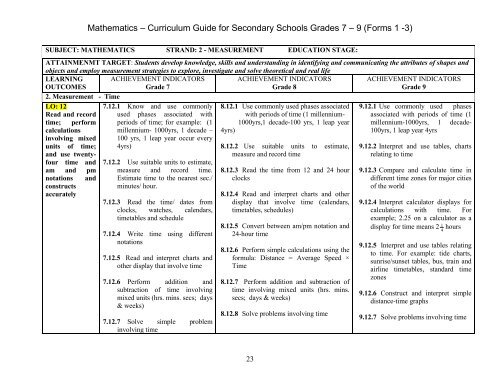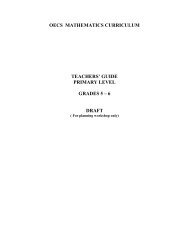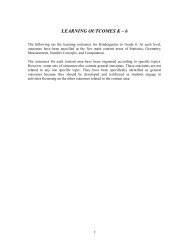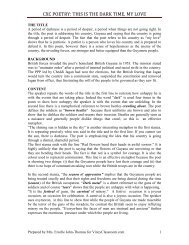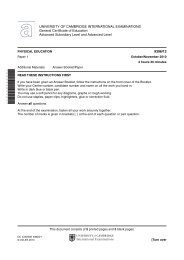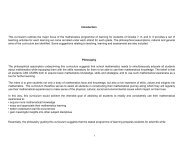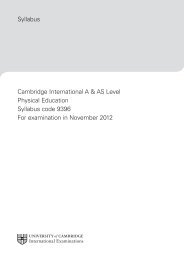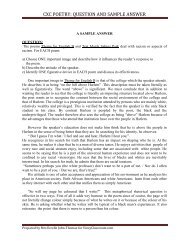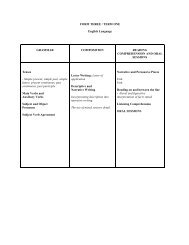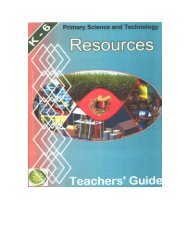Mathematics Programme of Learning - VincyClassroom
Mathematics Programme of Learning - VincyClassroom
Mathematics Programme of Learning - VincyClassroom
Create successful ePaper yourself
Turn your PDF publications into a flip-book with our unique Google optimized e-Paper software.
<strong>Mathematics</strong> – Curriculum Guide for Secondary Schools Grades 7 – 9 (Forms 1 -3)<br />
SUBJECT: MATHEMATICS STRAND: 2 - MEASUREMENT EDUCATION STAGE:<br />
ATTAINMENMT TARGET: Students develop knowledge, skills and understanding in identifying and communicating the attributes <strong>of</strong> shapes and<br />
objects and employ measurement strategies to explore, investigate and solve theoretical and real life<br />
LEARNING<br />
OUTCOMES<br />
ACHIEVEMENT INDICATORS<br />
Grade 7<br />
ACHIEVEMENT INDICATORS<br />
Grade 8<br />
ACHIEVEMENT INDICATORS<br />
Grade 9<br />
2. Measurement - Time<br />
LO: 12<br />
7.12.1 Know and use commonly 8.12.1 Use commonly used phases associated 9.12.1 Use commonly used phases<br />
Read and record used phases associated with with periods <strong>of</strong> time (1 millennium- associated with periods <strong>of</strong> time (1<br />
time; perform periods <strong>of</strong> time; for example: (1 1000yrs,1 decade-100 yrs, 1 leap year millennium-1000yrs, 1 decadecalculations<br />
involving mixed<br />
millennium- 1000yrs, 1 decade –<br />
100 yrs, 1 leap year occur every<br />
4yrs)<br />
100yrs, 1 leap year 4yrs<br />
units <strong>of</strong> time; 4yrs)<br />
8.12.2 Use suitable units to estimate, 9.12.2 Interpret and use tables, charts<br />
and use twentyfour<br />
time and<br />
measure and record time<br />
relating to time<br />
am and pm<br />
notations<br />
constructs<br />
accurately<br />
and<br />
7.12.2 Use suitable units to estimate,<br />
measure and record time.<br />
Estimate time to the nearest sec./<br />
minutes/ hour.<br />
7.12.3 Read the time/ dates from<br />
clocks, watches, calendars,<br />
timetables and schedule<br />
7.12.4 Write time using different<br />
notations<br />
7.12.5 Read and interpret charts and<br />
other display that involve time<br />
7.12.6 Perform addition and<br />
subtraction <strong>of</strong> time involving<br />
mixed units (hrs. mins. secs; days<br />
& weeks)<br />
7.12.7 Solve simple problem<br />
involving time<br />
8.12.3 Read the time from 12 and 24 hour<br />
clocks<br />
8.12.4 Read and interpret charts and other<br />
display that involve time (calendars,<br />
timetables, schedules)<br />
8.12.5 Convert between am/pm notation and<br />
24-hour time<br />
8.12.6 Perform simple calculations using the<br />
formula: Distance = Average Speed ×<br />
Time<br />
8.12.7 Perform addition and subtraction <strong>of</strong><br />
time involving mixed units (hrs. mins.<br />
secs; days & weeks)<br />
8.12.8 Solve problems involving time<br />
9.12.3 Compare and calculate time in<br />
different time zones for major cities<br />
<strong>of</strong> the world<br />
9.12.4 Interpret calculator displays for<br />
calculations with time. For<br />
example; 2.25 on a calculator as a<br />
display for time means 2 41<br />
hours<br />
9.12.5 Interpret and use tables relating<br />
to time. For example: tide charts,<br />
sunrise/sunset tables, bus, train and<br />
airline timetables, standard time<br />
zones<br />
9.12.6 Construct and interpret simple<br />
distance-time graphs<br />
9.12.7 Solve problems involving time<br />
23


